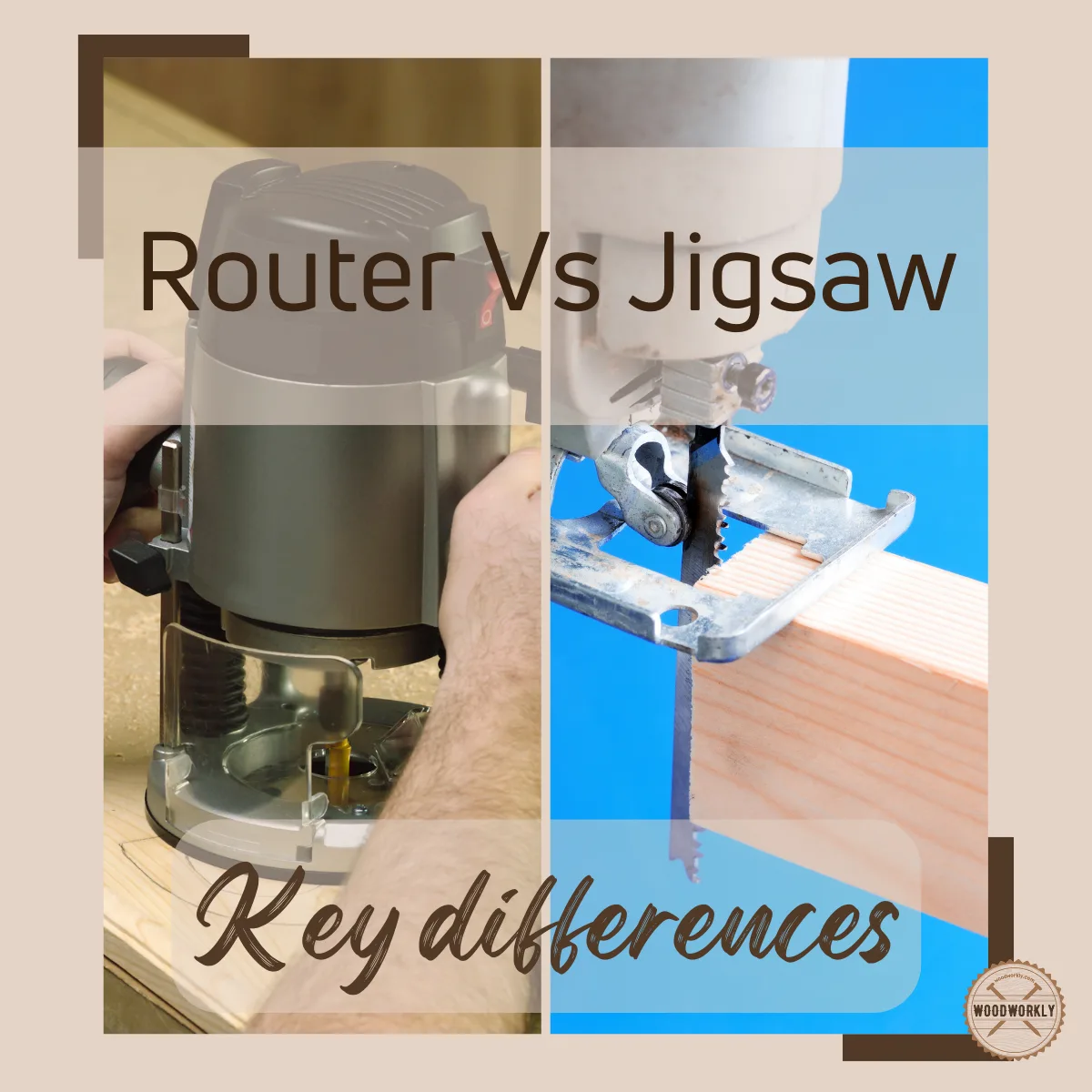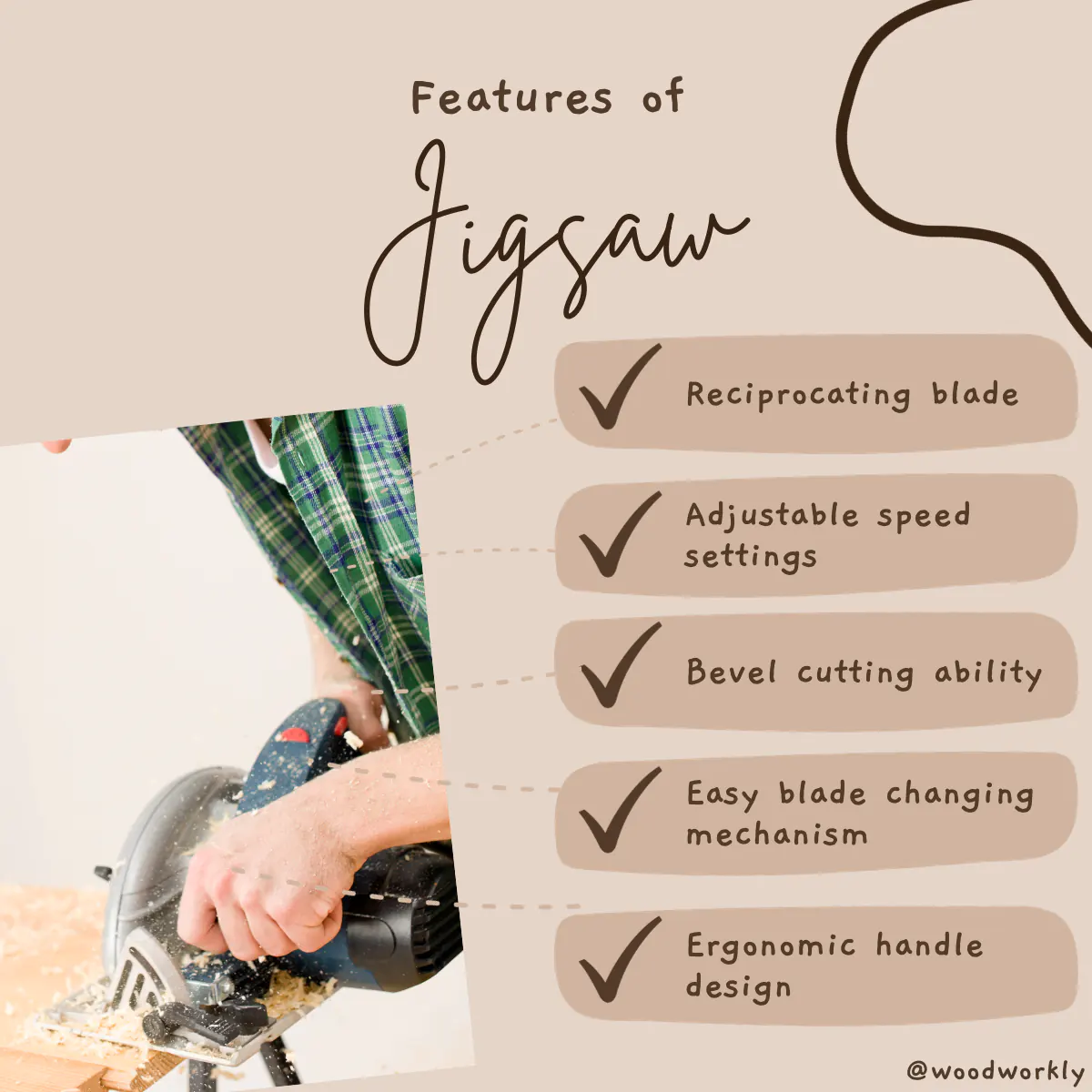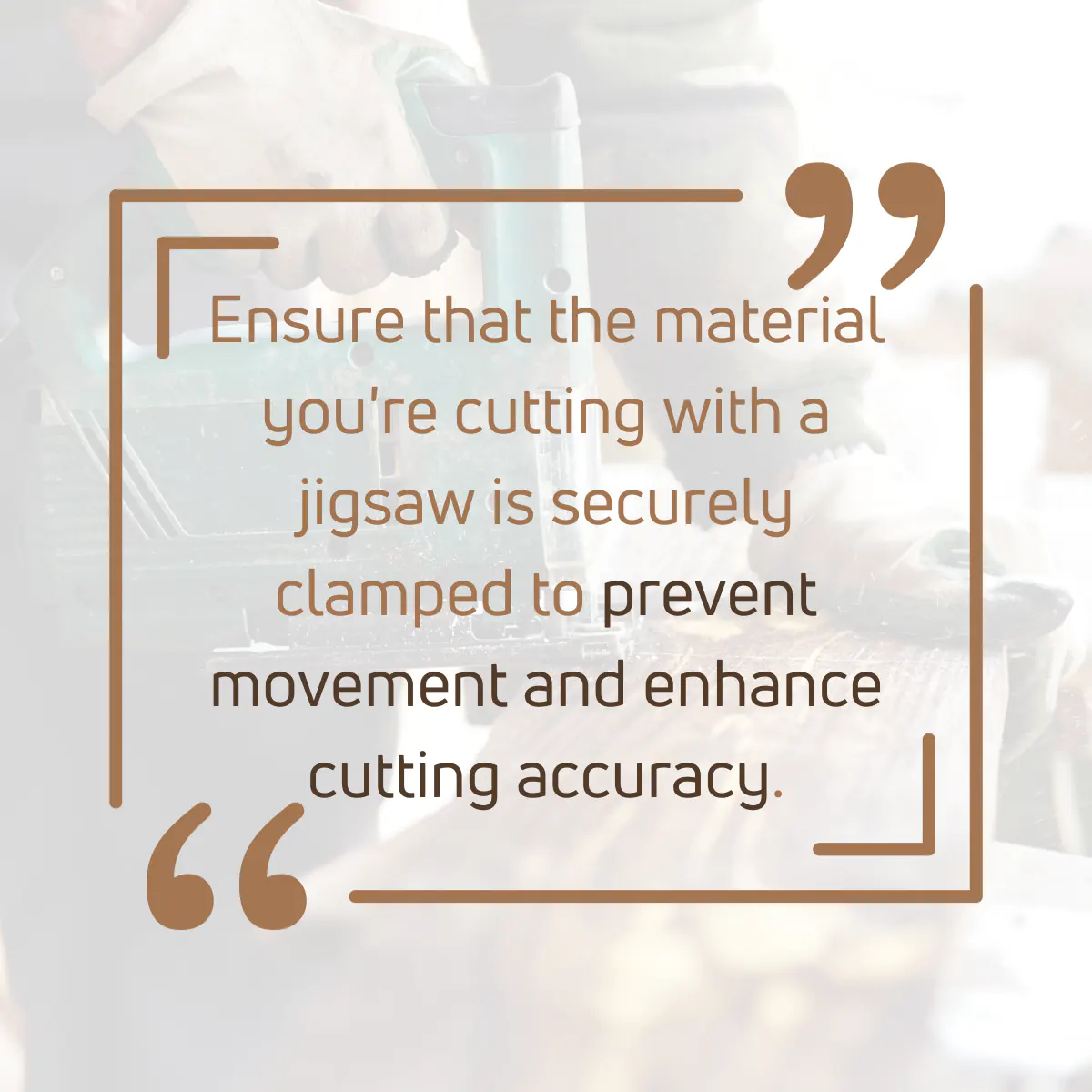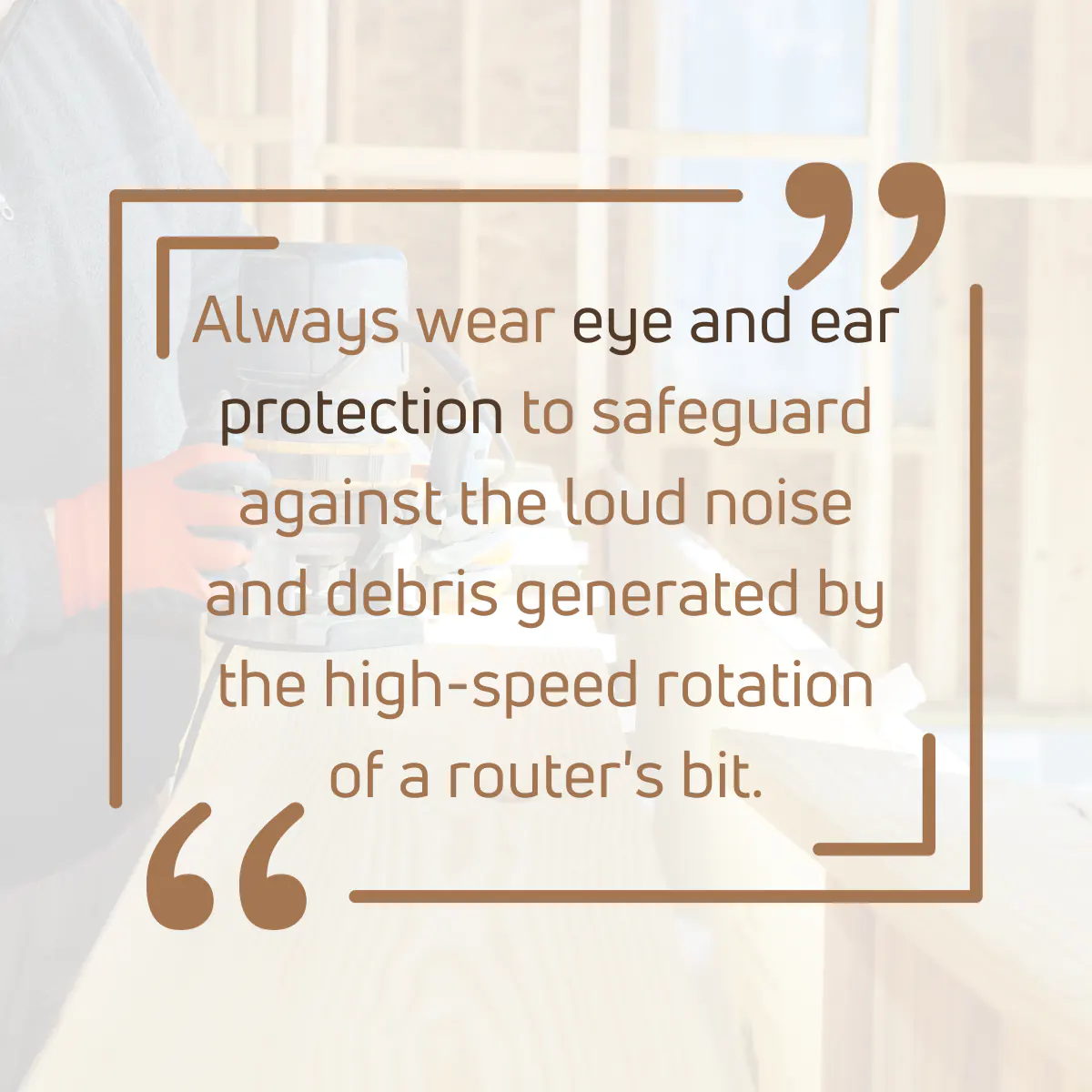Ever wonder whether a router or jigsaw suits your creative needs best? Discover the key differences and unveil which tool unlocks your ultimate woodworking potential!

As a woodworker, I use a variety of saws and other tools to cut and shape wood to meet my standards.
Two of the most commonly used tools are the jigsaw and the router. I was curious about their differences and had a hard time determining which one is superior.
So, I sought expert advice and gathered a wealth of information
Here are the the main differences between router vs jigsaw?
- A router’s bit spins, but a jigsaw’s blade reciprocates.
- A router can make small, correct cuts, yet a jigsaw can make deeper, less correct cuts.
- Jigsaws can cut circles, though they’re less precise than routers using templates and guides.
- Routers shine in shaping and good finishing, but jigsaws are skilled at doing curved and unique cuts.
- Setting up a router using templates and guides is harder than preparing a jigsaw for easy cuts.
- Switching out router bits takes longer than switching out blades on a jigsaw
- Given the range and power of routers, they aren’t as easy for beginners as jigsaws.
But there’s a lot more to know about each of those differences!

Make sure the tool you use is designed for the task at hand before making a decision. If you’re new to woodworking, I’ll explain how a router vs jigsaw is different from a router.
Let’s just dive in!

What Is the Main Difference between Router and Jigsaw?
The key difference between a router and a jigsaw is the fact a router serves primarily for shaping and finishing, but a jigsaw is mainly used for cutting curves and odd shapes in wood.
Do I Need a Router or Jigsaw?
Yes, both tools are vital for an expert woodworker like me. With a jigsaw, I can cut through wood, and a router is amazing for creating shapes.
Which one you choose rests fully on what sort of project you’re working on. Professionally, both appear to be very helpful.
What Is Router?
A typical wood router has a motor, housing, and wood-cutting bit. Motors can have 1/2- to 3-hp or extra and housing styles are fixed and plunge base.
In my opinion, it’s just a motor with a pointy spiny thing at the bottom.
I suggest that you keep in mind that bigger doesn’t mean better. If you work on smaller, delicate pieces, a large router with a big motor can be hard.

How to Use Router?
When you are using your router, follow these steps.
- Flip the Tool and Switch It Off When Placing the Router Bit
- Change Router Depth for Your Router Type and Task
- If Using a Variable-Speed Router, Select the Application Speed
- Connect a Dust Extractor
- Start Cutting opposite the Router Cutter’s Spin for Better Cutting.
- Left-Right Feed for Handheld Routers
- Right to Left for Router Tables
Let me explain these steps further.
1. Flip the Tool and Switch It Off When Placing the Router Bit
I suggest that you hold the router upside down and turn it off before adding the router bit.
2. Change Router Depth for Your Router Type and Task
You should set the router’s cutting depth to suit the model and task.
3. If Using a Variable-Speed Router, Select the Application Speed
If the router is a variable speed model, in my opinion, change it to fit your routing task.
4. Connect a Dust Extractor
You must use a dust extractor or vacuum to lessen router dirt and dust.
5. Start Cutting opposite the Router Cutter’s Spin for Better Cutting
I recommend setting the router against the cutter bit rotation to cut easily and correctly.
6. Left-Right Feed for Handheld Routers
You need to move a handheld router along the workpiece from left to right.
7. Right to Left for Router Tables
With a router table, you have to feed material from right to left along the router bit’s rotation.

Pros and Cons of Router
These are the pros and cons when using a router for your tasks.
Pros of Router
- Joins wood smoothly
- Many uses
- Handy for details
- Great for edges
Cons of Router
- Setup is challenging
- Bit may be dangerous
- Takes skill
- Noisy and dusty

Uses of Router
I’ll go over some router uses here.
- Shaping Edges – Your routers make it simple to round or angle the edges of wood swiftly.
- Joining Wood – From what I’ve experienced routers are wonderful to create different joints in wood.
- Trimming Flush – You should use routers to cleanly cut a single piece of wood to fit another.
- Installing Hinges – I recommend using a small router to drill holes for hinges makes it simpler to hang doors.
- Adding Decorative Patterns – You must use routers to create beautiful patterns into wooden displays.

What Is Jigsaw?
Easily used by DIYers and pros like me, a jigsaw can make simple or difficult curved cuts for crafting and woodworking.
In my experience, when you master jigsaw and have the correct blade, you too can cut wood, metal, laminate, and tile correctly like I do.

How to Use Jigsaw
If you choose to use a jigsaw I suggest you follow these steps.
- Choose a Suitable Blade
- Setting up the Jigsaw
- Prepare your Wood
- Cut the Wood
- Clean Up
Now I’ll explain these steps.
1. Choose a Suitable Blade
If you’re using wood your jigsaw requires a wood blade, but metal needs a metal blade.
2. Setting up the Jigsaw
I suggest putting the blade facing the correct way while the jigsaw is unplugged. Turn it on and cut.
3. Prepare your Wood
You need to mark the cutting line, secure the wood to a table, and make room for the jigsaw to move without hitting something.
4. Cut the Wood
Keep the jigsaw’s foot flat; begin moving the blade away from the wood, and I highly recommend you cut slowly without pushing.
5. Clean Up
You need to sand the edges, disconnect the jigsaw, remove the blade, then clean up your work area, and correctly get rid of the waste.

Pros and Cons of Jigsaw
If you use a jigsaw these are perks and drawbacks you should thing about.
Pros of Jigsaw
- Simple to carry
- Helpful for DIY
- Good for many things
- Cuts curves
Cons of Jigsaw
- Less precise
- Bad for thick materials
- Limited to straight cuts
- Leave rough edges

Uses of Jigsaw
You can use the jigsaw for many things. These are the things I use a jigsaw for:
- Creating Puzzle-Like Shapes – You can make difficult, puzzle-like patterns using it.
- Cutting Shapes – I always use a jigsaw creates curves and shapes.
- DIY Tasks – You need jigsaws since they are useful for many DIY works.
- Wood and Metal Trimming – In my experience, you can cut wood or metal using it.

Router vs Jigsaw Differences
Here is a table about the differences between Router VS Jigsaw.
| Characteristic | Router | Jigsaw |
| Cutting Depth | Shallow and correct | Deeper, but not as correct |
| Forms of Cuts | Shaping and adding tiny details | Curves and odd forms |
| Switching out the Blades | Takes more time | Simple to understand and do |
| Simple to Use | Needs knowledge and skill | More friendly to newbies |
| Tool for Cutting | Spinning bits | Reciprocating blades |
| Risk | High-speed bit, precision risk | Reciprocating blade, less risk |
| Cutting Rounds | Likely with guides or templates | Less correct, especially when done by hand |
| Setting up | Hard, usually based on templates | Simpler, less complicated |
Now I’ll tell you more about these differences between Router VS Jigsaw
1. Cutting Depth
In my experience a wood router has a limited cutting flute but allows you change cutting depth using the router bit protrusion. Cutting a large wood board needs many rounds.
The huge blade of jigsaws is perfect cutting large wood boards. From what I’ve experienced large cuts are simple using this tool.
Therefore, jigsaws are easier to use than wood routers.
2. Forms of Cuts
Both tools offer unique cutting skills, but from what I’ve learned you should be aware that they have different functions.
A wood router is a useful tool for cutting wood into different sizes and shapes. The depth of cut isn’t as deep as a jigsaw, though.
But in my opinion, cutting with a jigsaw is simpler.
3. Simple to Use
A jigsaw is easier for you to use than a wood router. A marker or pencil offers precise line drawing and clean, precise cutting. It has a base built for easy cutting.
When you create cuts with a router it can be hard. The rounded bits can rotate quickly, making them hard to track.
A router isn’t the best tool for you to get started with.

4. Tool for Cutting
The cutting ability of a router and jigsaw ranges greatly. Your router has a rotating bit. A reciprocating blade separates a jigsaw from your router.
Built for straight and curved cuts, jigsaws can cut a variety of things. However, routers are not saws. Rounding edges is what it is for.
5. Switching out the Blades
In my experience, router bits are difficult to swap out. You must lock and loosen the bit first. You need to remove and replace the bit.
You must again check that you have a strong grasp.
To loosen and remove a jigsaw blade, highly recommend using a screwdriver or Allen wrench.
6. Risk
From what I’ve experienced, you must be careful with power tools. I suggest you always wear protective gear to protect yourself.
Jigsaws have harmful reciprocating blades. A router has bits with above 24000 RPM and crushing sound.
In both instances, I highly advise you to handle them cautiously when working.
7. Cutting Rounds
While a wood router can be used to create detailed designs, you can also use it to cut perfect circles on your wood.
The rotating bits are able to form joints and polish edges.
A jigsaw is able to make a range of cuts. The circle-cutting skill is less than perfect for your wood.
You can begin a circular cut using a jigsaw and end it using a router.
8. Setting up
Jigsaws are simpler to set up than routers. You should simply draw a line to follow. Precision cutting is possible with many timbers.
Different guides are needed for routers.
The router layout complicates line-following. You need to use a guide since it serves to maintain the device on line.
Congrats folks! Now you know everything about router vs jigsaw with their properties, uses, differences, and how to use them.

Now I’m going to share with you some tips that I’ve learned by working with routers and jigsaw for different woodworking projects.
I’ve included some expert tips as well.
Just keep reading!
Tips for Working with Router
There are lots of things to keep in mind when using a router. So here are some tips to keep in mind.
- I suggest you keep your router neat and well-kept for the best results.
- You should always make sure your workpiece is securely fastened down.
- You need to change the depth of cut for the outcome you want.
- Set the right speed for the wood and router bit.
- To cut easily you must move opposite to the bit’s rotation.
- I highly advise you to use a guide or template for extra accuracy.
- Put on your safety glasses and ear protection.
- I recommend you put in a dust collector and you’ll enjoy a cleaner workplace.
- In my experience, you have to move slowly and carefully at first.
- Choose the best router bit for the job at hand.
- You should work with wasted wood to sharpen your skills.
- I suggest that you learn ways to set up a stable router table.
- In my opinion, a router stop helps to create consistent cuts.

Tips for Working with Jigsaw
Here is something you should keep in mind when you are using a jigsaw.
- Lock the wood down firmly before you begin cutting.
- Pick the correct blade for your jigsaw.
- Clearly mark where you want to make your cut.
- Begin a slow, deliberate cutting motion.
- To stop splintering, wood should be secured.
- Create straight cuts with the use of a guide or straight edge.
- Make curves in scrap wood to get the hang of it.
- Wear goggles and ear protection.
Ultimately, routers and jigsaws are two very different tools with very different uses.
In my opinion, which one you pick depends on your needs and the projects you want to handle. Skilled woodworkers like me are going to need both.

So, let’s answer some frequently asked questions.
FAQs
What is the primary function difference between a router and a jigsaw?
A router is primarily used for hollowing out an area in hard materials, such as wood or plastic, and creating detailed patterns and finishes, while a jigsaw is used for cutting through materials and is excellent for both straight and curved lines.
Which tool is easier to use for beginners?
Jigsaws are generally easier to handle, especially for beginners, due to their straightforward operation and the ability to make precise cuts by following a drawn line, unlike routers that require more skill and often a guide to achieve accurate cuts.
How do the cutting mechanisms of routers and jigsaws differ?
Routers use rotating bits to carve and shape materials, while jigsaws employ a reciprocating blade for cutting through materials, allowing a range of cut types including straight, curved, and angled cuts.
Can jigsaws and routers be used on materials other than wood?
Jigsaws are versatile tools capable of cutting through a variety of materials including wood, metal, and plastic, while routers are typically used on wood and similar hard materials.
Which tool is safer to use?
Jigsaws are generally considered safer because of their ease of control and lower operating speed compared to routers, which can be more dangerous due to their high-speed rotation and the level of skill required to operate them safely.
How do the depths of cuts compare between the two tools?
Jigsaws can make deeper cuts due to their longer blades and are ideal for cutting through thick materials, whereas routers have limited cutting depth, making them more suited for surface-level detailing and carving.
What are the typical uses for routers in woodworking?
Routers are extensively used for intricate and detailed woodworking tasks like creating joints, shaping edges, and hollowing out wood, offering a finished look that often requires minimal sanding.
How easy is it to change blades or bits on these tools?
Changing blades on a jigsaw is generally easier and requires basic tools like a screwdriver or an Allen wrench, while changing bits on a router can be more complex, often requiring a wrench and adjustments to depth settings.
Is it possible to use a router for making straight cuts?
While routers can technically make straight cuts, they are not ideally suited for this purpose, and achieving such cuts can be challenging without a guide; jigsaws or other types of saws are typically preferred for straight cuts.
Can routers and jigsaws be used for curved cuts?
Routers excel at creating detailed curved patterns and hollows thanks to their rotating bits, while jigsaws, with their reciprocating blades, are also capable of making curved cuts, although with less precision in detailing compared to routers.
Did I cover all you wanted to know about: Router Vs Jigsaw
In this article, I’ve deeply discussed router vs jigsaw with their uses and key differences in detail.
Router vs jigsaw include routers are used for hollowing out and detailing wood, featuring rotating bits for carving intricate designs while Jigsaws, with reciprocating blades, are optimal for straight and curved cuts through various materials. Routers excel in precision detailing, while jigsaws are versatile in cutting shapes and are generally easier and safer to use.
Furthermore, I’ve answered some frequently asked questions as well.
Hope you’ve learned all you wanted to know about router vs jigsaw in detail to select the one that suits you the most.
Now it’s time to go through this article again and again and select the machine taht perfectly matches your preference to achieve promising results for your woodworking project. All the best!